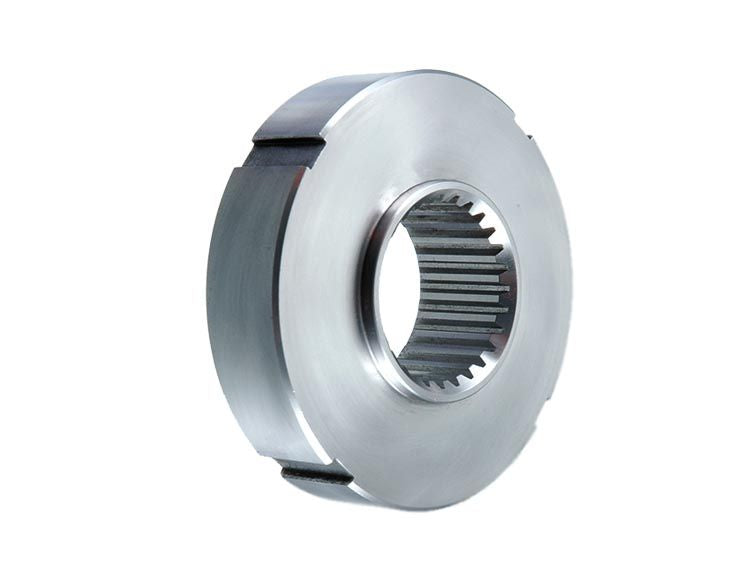Check Order Status

Torque Converter Sprags
Today's CDS Tech Tip Tuesday post is going to cover some basics of a topic we get asked about quite a bit; torque converter sprags!
There's a lot of information to cover on this topic, especially when it comes to sprag vs. spragless torque converters. Today's post is only intended to be a basic informative post to help educate on the differences in parts. We'll get more in depth into the whole sprag vs. spragless debate in another upcoming Tech Tip Tuesday post.
To begin, the term "sprag" has become a catch-all term over the years to describe the one-way clutch that is housed inside of the torque converter stator, but not all one-way clutches are created equal even though they all offer the same overall function inside a torque converter.
The first picture shows the most common design of stator one-way clutch. This design is a roller clutch. The inner race locates on the splines of the pump stator tube. The spring-loaded roller elements roll across the smooth face of the inner race whenever the stator is in an overrun condition.
When the torque converter is in a torque multiplying condition such as when coming up to stall speed, the roller clutch allows the stator to lock in position & stay stationary to help provide those torque multiplying characteristics via fluid flow redirection & acceleration through the stator vanes. The roller clutch does this job by allowing the spring-loaded roller elements to wedge themselves between the smooth inner race & the ramp profiles machined into the outer race. This wedge effect prevents the stator from rotating. As the loads increase that a stator roller clutch is subjected to, whether that be increased shock loading, increased engine torque, increased vehicle weight, etc., the ability of the roller clutch to endure increased loading can eventually get reduced to the point where a stronger, more durable one-way stator clutch becomes necessary.
This is where a true stator sprag comes into play as shown in the second picture. This sprag rides between two smooth races inside the stator.
The elements within the sprag have a unique cam profile on each side of the element. In a stator overrun condition the heels of the sprag elements allow for smooth, seamless rotation of the outer race & the sprag on the inner race which is held stationary to the pump stator tube via the splines in the inner race.
In a torque multiplication condition the unique cam shapes of the sprag elements allow the elements to roll over & wedge tightly between the smooth races, thus holding the stator stationary & preventing stator rotation so torque multiplication may take place as the converter is coming up to stall speed.
The increase in surface area provided by the additional elements present in a true sprag combined with the premium steel materials used to manufacture the sprag races will typically allow this design of one-way stator clutch to handle higher loads than a comparable roller clutch as discussed earlier, although there are certain aftermarket roller clutch designs that are an exception to this statement as well.
For applications that may exceed the capacity of a roller clutch or a sprag, the mechanical diode is the ultimate high-strength solution for one-way stator clutches.
The third picture shows a 10-strut mechanical diode, although 5-strut, 8-strut, & 9-strut variations all exist as well. A mechanical diode offers the same overall function inside a torque converter as a roller clutch or a sprag, but with the ability to handle significantly higher loads than either of the previously mentioned one-way stator clutches. This increase in strength comes from square-cut spring-loaded struts that positively lock into matching machined recesses within the inner & outer races. With this design there is no potential for skidding of roller clutch or sprag elements, nor is there potential for fracturing of an outer sprag race as can sometimes happen with the other two designs.
While a diode isn't an heirloom item that will absolutely last forever, a properly designed 9-strut or 10-strut diode is essentially "bulletproof" for the vast majority of combinations that may require a one-way stator clutch in the converter. Further, the diode is also serviceable provided excess wear or damage to the races is not present. Diodes may easily be rebuilt with new struts, springs, & spiral retaining ring if needed.
This brings us to our last stator clutch option & picture which isn't a one-way clutch at all, but is actually a clutch eliminator often referred to as a "spragless" stator hub. This clutch eliminator deletes the one-way stator clutch & permanently locks the stator assembly to the pump stator tube splines once the converter is installed into the transmission. By eliminating the one-way clutch all potential for one-way clutch wear and/or failure is eliminated, thus making for what is essentially the strongest torque converter possible.
The clutch eliminator does alter overall torque converter function as compared to a converter with an active stator via a one-way stator clutch, so even though a spragless converter is overall stronger, it is not always the best solution for all applications utilizing a performance-oriented torque converter.
We're going to close the post on that note, so be sure to tune in to our next Tech Tip Tuesday where we'll take a deeper dive into the "hows" & "whys" of sprag vs. spragless torque converters along with the pros & cons of each.

